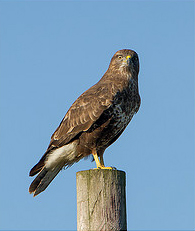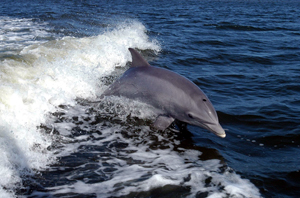|
Wildlife
 The North Highlands are home to several species of birds of prey, all of which may be observed by being in the right place at the right time. They range from the Golden Eagle to the tiny fast flying Merlin. All of the smaller species, including Buzzards, perch on objects such as fence posts or electricity poles whereas Golden Eagles are most common seen soaring over mountain ridges and remote areas, as they are very wary of humans. The White-tailed Sea Eagle was reintroduced from Norway, in 1975 and later, and is now firmly established in Skye, Rum, Mull and Wester Ross.
The North Highlands are home to several species of birds of prey, all of which may be observed by being in the right place at the right time. They range from the Golden Eagle to the tiny fast flying Merlin. All of the smaller species, including Buzzards, perch on objects such as fence posts or electricity poles whereas Golden Eagles are most common seen soaring over mountain ridges and remote areas, as they are very wary of humans. The White-tailed Sea Eagle was reintroduced from Norway, in 1975 and later, and is now firmly established in Skye, Rum, Mull and Wester Ross.
The Osprey is a migratory species and eventually returned on its own, first breeding again at Loch Garten in 1954. They now breed at several locations and may regularly be seen fishing at Loch Fleet, the Beauly Firth, Loch Shin or similar places where salmon and sea trout are present.
The Red Kite has also been successfully reintroduced, from Wales, in several areas, including the Black Isle, and can be regularly seen flying over the A9 at the Tore roundabout.
 The Common Buzzard is probably the most common bird of prey in the UK, and it is regularly seen along roadsides perched on whatever it can find!
The Common Buzzard is probably the most common bird of prey in the UK, and it is regularly seen along roadsides perched on whatever it can find!
Red deer are prevalent on moorlands in the Highlands although, for most of the year stags tend to range higher into the mountains while the females remain on richer pasture. Roe deer are smaller than their cousins and tend to frequent mixed woodland. They are common throughout Scotland, prefer lower altitudes and are more solitary.
Otters and wildcats are other fauna but glimpses of either are rare – otters tend to dive into ditches or under seaweed and wildcats are very timid and are rarely seen near human habitation.
 The Cromarty Firth is regularly visited by bottlenose dolphins, around 195 of which are resident in the wider Moray Firth. (Aberdeen University researchers have been studying and monitoring their population and distribution since 1989). These are the most northerly of only two resident populations in British seas, the other being found off west Wales, in Cardigan Bay.
The Cromarty Firth is regularly visited by bottlenose dolphins, around 195 of which are resident in the wider Moray Firth. (Aberdeen University researchers have been studying and monitoring their population and distribution since 1989). These are the most northerly of only two resident populations in British seas, the other being found off west Wales, in Cardigan Bay.
The sandbanks of the Cromarty and Dornoch Firths are home to a population of around 300 harbour seals, with more than 300 more in the Inner Moray Firth (from Ardersier to Beauly). The area is designated a Special Area of Conservation because of their importance. They hunt fish such as herring, sand eels, whitefish, and flatfish, using their whiskers to detect changes in underwater vibrations. Harbour porpoises and grey seals also live here while minke whales seasonally migrate. Larger animals such as humpback whales, Northern bottlenose whales, long-finned pilot whales, common dolphins, large fish such as the sunfish and basking sharks are occasionally spotted visiting the firth.
 The Cromarty Firth is the most northerly major wintering area in Europe for ducks, geese and waders, an international travel destination for over 30,000 birds. The numbers in which some species flock to the Firth - including greylag geese, knot, bar-tailed godwit, curlew, dunlin and pintail - have been recognised in international designations. The Firth is a Special Protection Area for birds and a ‘Ramsar site’ for internationally important mudflats and sandflats, and the birds that feed there. The RSPB has nature reserves at Nigg Bay and Udale Bay, but the mudflats all along the north shore of the firth provide important feeding grounds, as they are full of food from lugworm and cockles to the rich green strands of eelgrass and twenty-one species of algae.
The Cromarty Firth is the most northerly major wintering area in Europe for ducks, geese and waders, an international travel destination for over 30,000 birds. The numbers in which some species flock to the Firth - including greylag geese, knot, bar-tailed godwit, curlew, dunlin and pintail - have been recognised in international designations. The Firth is a Special Protection Area for birds and a ‘Ramsar site’ for internationally important mudflats and sandflats, and the birds that feed there. The RSPB has nature reserves at Nigg Bay and Udale Bay, but the mudflats all along the north shore of the firth provide important feeding grounds, as they are full of food from lugworm and cockles to the rich green strands of eelgrass and twenty-one species of algae.
 Each year 8,000 to 20,000 salmon return to the river systems of the Conon, Glass, Sgitheach, Alness and Balnagown, travelling upstream to spawn. Between 150,000 and 200,000 of their smolts (aged between two and four years), make their way between the headlands of the Sutors, and out into the North Sea and Atlantic Ocean beyond.
Each year 8,000 to 20,000 salmon return to the river systems of the Conon, Glass, Sgitheach, Alness and Balnagown, travelling upstream to spawn. Between 150,000 and 200,000 of their smolts (aged between two and four years), make their way between the headlands of the Sutors, and out into the North Sea and Atlantic Ocean beyond.
|

